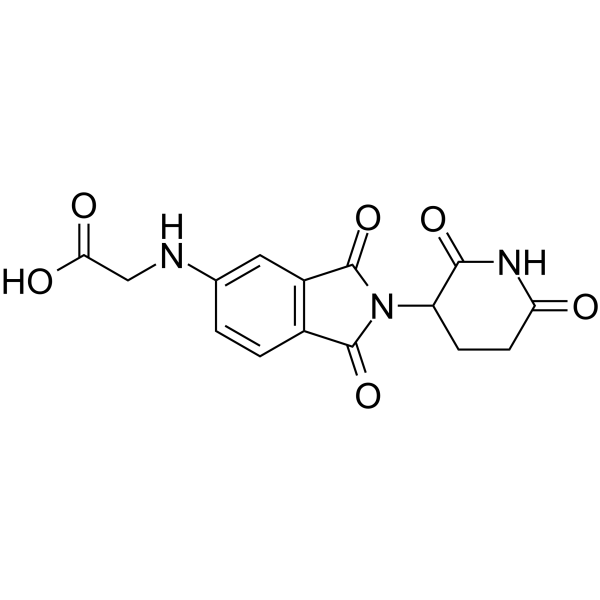
Thalidomide-5-NH2-CH2-COOH
CAS No. 2412056-27-8
Thalidomide-5-NH2-CH2-COOH( (2-(2,6-dioxopiperidin-3-yl)-1,3-dioxoisoindolin-5-yl)glycine )
Catalog No. M28263 CAS No. 2412056-27-8
(2-(2,6-dioxopiperidin-3-yl)-1,3-dioxoisoindolin-5-yl)glycine is a chemical compound.
Purity : >98% (HPLC)
 COA
COA
 Datasheet
Datasheet
 HNMR
HNMR
 HPLC
HPLC
 MSDS
MSDS
 Handing Instructions
Handing Instructions
| Size | Price / USD | Stock | Quantity |
| 2MG | 67 | Get Quote |


|
| 5MG | 110 | Get Quote |


|
| 10MG | 161 | Get Quote |


|
| 25MG | 267 | Get Quote |


|
| 50MG | 439 | Get Quote |


|
| 100MG | 644 | Get Quote |


|
| 500MG | 1332 | Get Quote |


|
| 1G | Get Quote | Get Quote |


|
Biological Information
-
Product NameThalidomide-5-NH2-CH2-COOH
-
NoteResearch use only, not for human use.
-
Brief Description(2-(2,6-dioxopiperidin-3-yl)-1,3-dioxoisoindolin-5-yl)glycine is a chemical compound.
-
Description(2-(2,6-dioxopiperidin-3-yl)-1,3-dioxoisoindolin-5-yl)glycine is a chemical compound.
-
In Vitro——
-
In Vivo——
-
Synonyms(2-(2,6-dioxopiperidin-3-yl)-1,3-dioxoisoindolin-5-yl)glycine
-
PathwayOthers
-
TargetOther Targets
-
RecptorFAK|c-Src|PI3K|Rac1|MMP-2|MMP-9
-
Research Area——
-
Indication——
Chemical Information
-
CAS Number2412056-27-8
-
Formula Weight331.28
-
Molecular FormulaC15H13N3O6
-
Purity>98% (HPLC)
-
SolubilityIn Vitro:?DMSO : 33.33 mg/mL (100.61 mM)
-
SMILESOC(CNc(cc1)cc(C(N2C(CCC(N3)=O)C3=O)=O)c1C2=O)=O
-
Chemical Name——
Shipping & Storage Information
-
Storage(-20℃)
-
ShippingWith Ice Pack
-
Stability≥ 2 years
Reference
1.Dai F, et al. A novel synthetic small molecule YH-306 suppresses colorectal tumour growth and metastasis via FAK pathway. J Cell Mol Med. 2015 Feb;19(2):383-95.
molnova catalog



related products
-
Notoptol
Notoptol is a natural product of Notopterygium, Apiaceae. Notoptol can be used as a reference standard.
-
Fibrinogen-Binding P...
Fibrinogen-Binding Peptide (designed by anticomplementarity hypothesis) is a presumptive peptide mimic of the vitronectin binding site on the fibrinogen receptor. Fibrinogen, a soluble plasma protein, is a cofactor in platelet activation. It is converted to fibrin in a reaction catalyzed by thrombin.
-
Leucomalachite green
Leucomalachite green is used in detecting latent bloodstains and in the forensic field because of convenience and cost/time-effectiveness.



 Cart
Cart
 sales@molnova.com
sales@molnova.com


